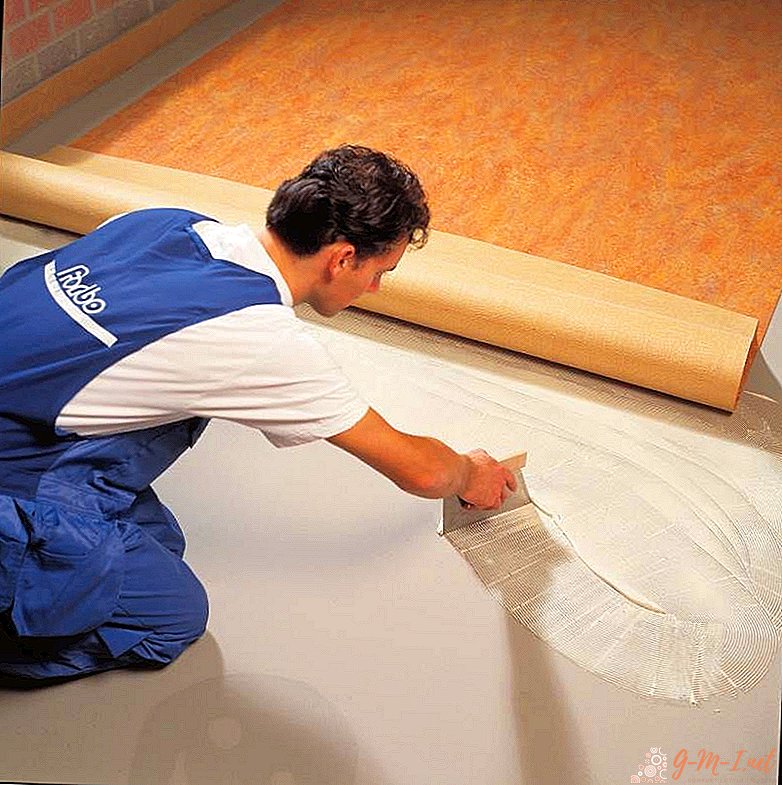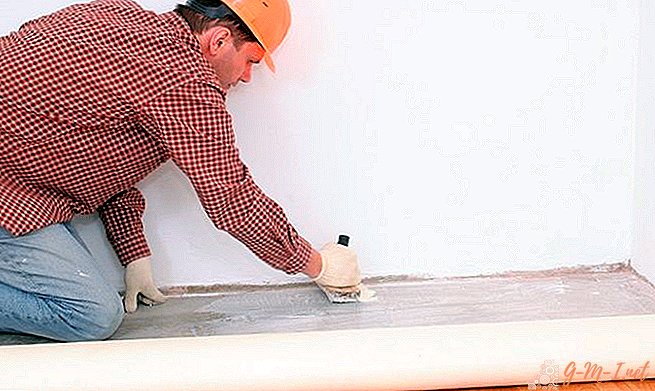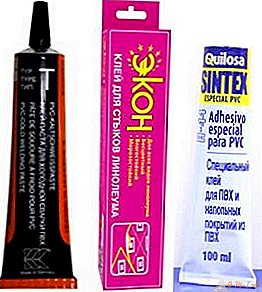Concrete floors are characterized by the ratio of sand, gravel or other fillers. But for those who decide to hide an unsightly draft version, this does not matter, because any concrete is able to absorb and retain the components of the materials adjacent to it. And this is good for those who intend to hide it under the decorative layer once and "for life." However, linoleum, to the dismay of dreamers, tends to wear out. Therefore, it must be changed occasionally. But to bite off the old coating by a millimeter is not quite the occupation that you will want to do in 15-20 years.

What, what and why
Manufacturers have developed a large number of adhesives. They reliably hold the coating web in place during operation, but make it easy to “unhook” it from concrete in case of replacement. Moreover, the compositions are developed taking into account the features of the decorative flooring; modifiers are not washed out of them. And in order to stimulate too thrifty customers, manufacturers insist on the obligatory gluing of linoleum to the floor - otherwise they simply do not give a guarantee. After all, a securely fixed coating lasts 40-60% longer than that fixed with baseboards.

The method of fixing the decorative coating with strips is called dry. It is applicable only when using roll linoleum, only in rooms up to 20 m2 and only with low traffic. For example: in the pantry or bedroom, you can lay it this way, but in the living room or hallway, you can’t.
You can attach the floor to the floor in three ways:
- with glue;
- using mastic;
- on bilateral construction tape.
Glue
This substance is quite elastic and well fixes the joined surfaces. Depending on the conditions, when installing linoleum, its various types are used.

Water soluble - is based on acrylic or polyvinyl acetate. It is used in residential and heated rooms. Safe for human health - even use in children's rooms is allowed. Acrylic compounds are divided into:
- acrylate - for coating on a synthetic or jute basis;
- humilax - for marmoleum (natural linoleum);
- bustilate - for the insulated version.
Reactionary - toxicity in combination with a pungent odor makes this glue unsuitable for use in residential premises. It is not afraid of temperature changes and reliably fastens the connected surfaces. One of its types is cold welding, which can be of two types:
- A - for new linoleum;
- C - for the former.
When using any glue, it is recommended to pre-lay the waterproofing layer of the coating.
Mastic

This group of compounds is not afraid of moisture and allows you to hide minor defects of the subfloor. Distinguish:
- bitumen - for coating on a fabric basis;
- dispersion - for linoleum with pile;
- mastic based on synthetic resins and rubber - for polyvinyl chloride and alkyd coating without a substrate.
Depending on the type of mastic, the methods of working with it also differ. So, the first pair allows the use of a metal spatula during application, the last variety is not, because there is a risk of fire and explosion. The thickness of the working layer, the method of its application and the waiting time before pasting, they also differ, so you should carefully study the instructions for use.
Alternative option
Quite often there is a recommendation to use mounting double-sided tape to fix linoleum on the subfloor. This method has the right to life only under the condition of a small load on the coating. Moreover, it does not differ in durability - as soon as the adhesive layer dries, it will lag behind concrete. And this will happen no later than 5 years after the start of linoleum operation.

If you really want to save brighter parting speeches of the linoleum manufacturer, then you can seriously reduce the consumption of the recommended adhesive composition. To do this, it is necessary to apply it not in a continuous layer, but pointwise: lines along the contour of the edges and a few "spots" inside the perimeter. But again - the trick is not applicable in places with high traffic.

Leave Your Comment